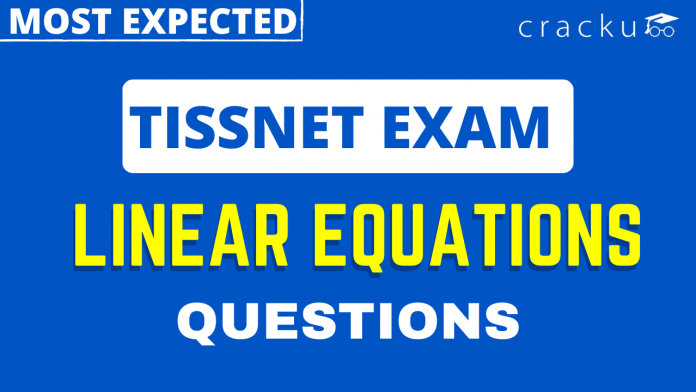TISSNET Linear Equations Questions PDF
Download Linear Equations Questions for TISSNET PDF – TISSNET Linear Equations questions PDF by Cracku. Practice TISSNET solved Linear Equations Questions paper tests, and these are the practice question to have a firm grasp on the Linear Equations topic in the TISSNET exam. Top 20 very Important Linear Equations Questions for TISSNET based on asked questions in previous exam papers. The TISSNET question papers contain actual questions asked with answers and solutions.
Download Linear Equations Questions for TISSNET
Enroll to TISSNET 2023 Crash Course
Question 1: In 1 kg of a mixture of sand and iron, 20% is iron .How such sand should be added so that the proportion of iron becomes 10%
a) 1 kg
b) 200gm
c) 800 gm
d) 1.8 kg
e) None of these
1) Answer (A)
Solution:
Total mixture of sand and iron = 1 kg
Quantity of iron = $\frac{20}{100} \times 1 = 0.2$ kg
Let $x$ kg of sand should be added, thus total iron in the mixture
=> $0.2=\frac{10}{100} \times (x+1)$
=> $2=x+1$
=> $x=2-1=1$ kg
=> Ans – (A)
Instructions
Each of the questions below consists of a question and two statements numbered I and II given below it. You have to decide whether the data provided in the statements are sufficient to
answer the question. Read both the statements and answer the below questions
a: if the data in Statement I alone are sufficient to answer the question, while the data in Statement II alone are not sufficient to answer the question.
b: if the data in Statement II alone are sufficient to answer the question, while the data in Statement I alone are not sufficient to answer the question.
c: if the data either in Statement I alone or in Statement II alone are sufficient to answer the question.
d: if the data even in both Statements I and II together are not sufficient to answer the question.
e: if the data in both Statements I and II together are necessary to answer the question.
Question 2: Who amongst the six friends M, N, 0, P, Q and R – is the heaviest?
I. O is heavier than only two friends. P is heavier than Q. P is lighter than N.
II. M is lighter than only two friends. N is heavier than O. N is lighter than R. P is heavier than Q.
a) if the data in Statement I alone are sufficient to answer the question, while the data in Statement II alone are not sufficient to answer the question.
b) if the data in Statement II alone are sufficient to answer the question, while the data in Statement I alone are not sufficient to answer the question.
c) if the data either in Statement I alone or in Statement II alone are sufficient to answer the question.
d) if the data even in both Statements I and II together are not sufficient to answer the question.
e) if the data in both Statements I and II together are necessary to answer the question.
2) Answer (E)
Solution:
Let us give ranks to the 6 friends, where 1 -> heaviest and 6 -> lightest.
I : O is heavier than only two friends, => O = 4
P is heavier than Q and P is lighter than N, => N > P > Q
But, there is no information about R and M. So, we cannot determine who is the heaviest.
Thus, I alone is insufficient.
II : M is lighter than only two friends, => M = 3
N is heavier than O and N is lighter than R, => R > N > O
Here, also the same problem arises.
Thus, II alone is insufficient.
I & II : Combining the above statements, we get :
M = 3 and O = 4
Since, R > N > O, => R = 1 and N = 2
Also, P > Q, => P = 5 and Q = 6
$\therefore$ R > N > M > O > P > Q
R is the heaviest.
Thus, I & II together are sufficient.
Question 3: P. Q and R have a certain amount of money with themselves. Q has 25% more than what P has, and R has ${1 \over 5}$th of what Q has. If P. Q and R together have Rs. 150, then how much money does P alone have? (in Rs.)
a) 40
b) 70
c) 80
d) 60
e) 50
3) Answer (D)
Solution:
Let P has = $Rs. 100x$
=> Amount with Q = $100x + \frac{25}{100} \times 100x = Rs. 125x$
=> Amount with R = $\frac{1}{5} \times 125x = Rs. 25x$
Total amount together = $100x + 125x + 25x = 150$
=> $x = \frac{150}{250} = \frac{3}{5}$
=> $x = 0.6$
$\therefore$ Amount with P alone = $100 \times 0.6 = Rs. 60$
Question 4: Among five people – A, B, C, D and E — each scoring different marks, only one person scored less marks than B. D scored more marks than B but less than A. A did not score the highest marks. Who scored the second highest marks?
a) E
b) Cannot be determined
c) A
d) C
e) D
4) Answer (C)
Solution:
Let us rank the person according to the marks scored by them, where 1 -> highest marks and 5 -> lowest marks.
Only one person scored less marks than B, => B = 4
Also, A > D > B and $A \neq 1$
=> A = 2 and D = 3
Thus, ranking from 1-5 = C/E , A , D , B , E/C
$\therefore$ A scored the second highest marks.
Question 5: A, B and C have a certain amount of money with themselves. C has ${3 \over 4}$ of what A has and B has Rs. 50 less than C. If A, B and C together have Rs. 250, then how much does A alone have? (in Rs.)
a) 75
b) 160
c) 80
d) 120
e) 140
5) Answer (D)
Solution:
Amount with A = $Rs. 4x$
=> Amount with C = $\frac{3}{4} \times 4x = Rs. 3x$
=> Amount with B = $Rs. (3x – 50)$
Total amount with A,B & C = $4x + 3x + (3x – 50) = 250$
=> $10x = 250 + 50 = 300$
=> $x = \frac{300}{10} = 30$
$\therefore$ Amount with A = $4 \times 30 = Rs. 120$
Question 6: If an amount of Rs. 97836 is distributed equally amongst 31 children, how much amount would each child get ?
a) Rs. 3756
b) Rs. 3556
c) Rs. 3356
d) Rs. 3156
e) None of these
6) Answer (D)
Solution:
Total amount = 97836
No. of children = 31
Since amount is distributed equally
=> Amount each child will get = $\frac{97836}{31}$ = Rs. 3,156
Question 7: In a class of 30 students and 2 teachers, ‘each student got sweets that are 20% of the total number of students and each teacher got sweets that are 30% of the total number of students. How many sweets were there ?
a) 188
b) 180
c) 208
d) 178
e) None of these
7) Answer (E)
Solution:
There are 30 students and 2 teachers.
Sweets received by each student = $\frac{20}{100} * 30$ = 6
=> Total sweets received by all the students = 30 * 6 = 180
Sweets received by each teacher = $\frac{30}{100} * 30$ = 9
=> Total sweets received by both teachers = 2 * 9 = 18
$\therefore$ Total sweets distributed in class = 180 + 18 = 198
Question 8: The cost of 20 folders and 15 pens is Rs. 995. What is the cost of 12 folders and 9 pens ?
a) Rs. 652
b) Rs. 597
c) Rs. 447
d) Cannot be determined
e) None of these
8) Answer (B)
Solution:
Let the cost of a folder = Rs. $x$
and cost of a pen = Rs. $y$
=> $20x + 15y = 995$
Multiplying the above equation by $(\frac{3}{5})$, we get :
=> $\frac{3}{5} \times (20x + 15y = 995)$
=> $12x + 9y = 597$
$\therefore$ Cost of 12 folders and 9 pens is Rs. 597
Question 9: The cost of 12 note-books and 16 pens is Rs. 852. What is the cost of 9 note-books and 12 pen?
a) Rs. 743
b) Rs. 639
c) Rs. 567
d) Cannot be determined
e) None of these
9) Answer (B)
Solution:
Let the cost of a note-book = Rs. $x$
and cost of a pen = Rs. $y$
=> $12x + 16y = 852$
Multiplying the above equation by $(\frac{3}{4})$, we get :
=> $\frac{3}{4} \times (12x + 16y = 852)$
=> $9x + 12y = 639$
$\therefore$ Cost of 9 note-books and 12 pens is Rs. 639
Question 10: The cost of 10 Chairs and 15 Tables is Rs. 15,525/-. What is the cost of 8 Chairs and 12 Tables?
a) Rs. 13,560/-
b) Rs. 12,420/-
c) Rs. 14,840/-
d) Cannot be determined
e) None of these
10) Answer (B)
Solution:
Let the cost of a chair = Rs. $x$
and cost of a table = Rs. $y$
=> $10x + 15y = 15525$
Multiplying the above equation by $(\frac{4}{5})$, we get :
=> $\frac{4}{5} \times (10x + 15y = 15525)$
=> $8x + 12y = 12420$
$\therefore$ Cost of 8 chairs and 12 tables is Rs. 12,420
Question 11: A trader sells 150 metres of cloth for Rs. 6,600 and he sells 300 metres of cloth for Rs. 12,750. How much concession does the trader give per metre of cloth, when he sells 300 metres of cloth?
a) Rs. 3
b) Rs.2.5
c) Rs. 1.5
d) Rs. 2
e) None of these
11) Answer (C)
Solution:
Case I : Trader sells 150 metres of cloth for Rs. 6,600
=> S.P. per metre = Rs. $\frac{6600}{150}$
= Rs. 44
Case II : Trader sells 300 metres of cloth for Rs. 12,750
=> S.P. per metre = Rs. $\frac{12750}{300}$
= Rs. 42.5
$\therefore$ Required discount = Rs. (44 – 42.5) = Rs. 1.5
Question 12: Cost of 20 pens and 17 pencils is Rs. 418. What is the cost of 60 pens and 51 pencils ?
a) Rs. 1.251
b) Rs. 1.257
c) Rs. 1,227
d) Rs. 1,221
e) None of these
12) Answer (E)
Solution:
C.P. of 1 pen = Rs. $x$
C.P. of 1 pencil = Rs. $y$
=> $20x + 17y = 418$
Multiplying above equations by 3
$\therefore$ $60x + 51y = 1254$
Question 13: Cost of 36 pens and 42 pencils is Rs.460/-. What is the cost of 18 pens and 21 pencils?
a) Rs.230/-
b) Rs.203/-
c) Rs.302/-
d) Rs.320/-
e) None of these
13) Answer (A)
Solution:
Cost of 36 pens and 42 pencils = 460
Dividing by 2, we get :
=> cost of 18 pens and 21 pencils = $\frac{460}{2}$ = Rs. 230
Instructions
Study the following information carefully and answer the questions given below :
<p “=””>Ten people are sitting in two parallel rows containing five people each, in such a way that there is an equal distance between adjacent people. In Row – 1, R, S, T, U and V-are seated and all of them are facing north. In Row – 2, F, G, H, I and J are seated and all of them are facing south. Therefore, in the given seating arrangement each member seated in a row faces another member of the other row. T is sitting third to the right of the person who faces F. Only two people are sitting between F and I. The person who faces U sits to the immediate left of H. Only one person is sitting between H and J. The one who faces G sits second to the right of R. H does not face V.
Question 14: Who among the following faces S?
a) G
b) J
c) F
d) I
e) H
14) Answer (E)
Solution:
There are 2 people sitting between F and I and T is sitting third to the right of one facing F.
=> I is sitting opposite T and F is sitting at second position in row 1.
There is only 1 person between H and J. Thus, G is sitting at position 4 in row 1.
The person sitting second to the right of R faces G.
=> R is sitting at second position in row 2.
The above arrangement is :
.PNG)
Clearly, H is facing S
Ans – (E)
Question 15: Which of the following statements is/are true on the basis of given information ?
a) F faces U
b) U sits exactly between S and T
c) J is an immediate neighbour of I
d) J faces one of the immediate neighbours of S
e) None is true
15) Answer (B)
Solution:
There are 2 people sitting between F and I and T is sitting third to the right of one facing F.
=> I is sitting opposite T and F is sitting at second position in row 1.
There is only 1 person between H and J. Thus, G is sitting at position 4 in row 1.
The person sitting second to the right of R faces G.
=> R is sitting at second position in row 2.
The above arrangement is :
.PNG)
U sits between S and T.
Ans – (B)
Question 16: Which of the following statements is/are true regarding G?
a) J is sitting second to the right of G
b) Only two persons sit between G and I
c) V is the immediate neighbour of that person who faces G
d) Both H and I are immediate neighbours of G.
e) None is true
16) Answer (D)
Solution:
There are 2 people sitting between F and I and T is sitting third to the right of one facing F.
=> I is sitting opposite T and F is sitting at second position in row 1.
There is only 1 person between H and J. Thus, G is sitting at position 4 in row 1.
The person sitting second to the right of R faces G.
=> R is sitting at second position in row 2.
The above arrangement is :
.PNG)
Both, H and I are immediate neighbours of G
Ans – (D)
Question 17: Who amongst the following is sitting to the immediate right of the person who faces R ?
a) J
b) I
c) H
d) F
e) G
17) Answer (A)
Solution:
There are 2 people sitting between F and I and T is sitting third to the right of one facing F.
=> I is sitting opposite T and F is sitting at second position in row 1.
There is only 1 person between H and J. Thus, G is sitting at position 4 in row 1.
The person sitting second to the right of R faces G.
=> R is sitting at second position in row 2.
The above arrangement is :
.PNG)
Clearly, J is sitting to the immediate right of the person(F) who faces R
Ans – (A)
Question 18: Which of the following groups of people represent the persons sitting at the extreme ends of both the rows ?
a) F, J, R, U
b) F, J, S, V
c) I, J, T, V
d) G, H, R, T
e) F, G, R, T
18) Answer (C)
Solution:
There are 2 people sitting between F and I and T is sitting third to the right of one facing F.
=> I is sitting opposite T and F is sitting at second position in row 1.
There is only 1 person between H and J. Thus, G is sitting at position 4 in row 1.
The person sitting second to the right of R faces G.
=> R is sitting at second position in row 2.
The above arrangement is :
.PNG)
I,J,T,V are sitting at the ends.
Ans – (C)
Question 19: Ram was asked to find 7/8 of a fraction but he mistakenly divided the fraction by 7/8 . As a result the difference between the answers was 75/784 . What should be the Ram’s correct answer ?
a) $\frac{5}{14}$
b) $\frac{7}{16}$
c) $\frac{5}{16}$
d) $\frac{7}{14}$
e) None of these
19) Answer (C)
Solution:
Let fraction be $x$
Ram’s correct answer should be = $\frac{7}{8}x$
Ram’s actual answer = $\frac{x}{\frac{7}{8}}=\frac{8}{7}x$
Difference = $\frac{8x}{7}-\frac{7x}{8}=\frac{75}{784}$
=> $\frac{(64x-49x)}{56}=\frac{75}{784}$
=> $15x=\frac{75}{784}\times56$
=> $x=\frac{75}{14}\times\frac{1}{15}$
=> $x=\frac{5}{14}$
$\therefore$ Ram’s correct answer should be = $\frac{7}{8}\times\frac{5}{14}=\frac{5}{16}$
=> Ans – (C)
Question 20: Some capsules were bought for Rs. 176. If the price of each capsule had been Rs. 3 less, 6 more capsules would have been bought for the same amount. What was the number of capsules bought ?
a) 13
b) 16
c) 17
d) 8
e) 11
20) Answer (B)
Solution:
Let capsules bought = $x$
Acc. to ques,
=> $\frac{176}{x} – \frac{176}{x + 6} = 3$
=> $\frac{176 \times 6}{x (x + 6)} = 3$
=> $x (x + 6) = 352 = 22 \times 16$
=> $x (x + 6) = 16 (16 + 6)$
=> $x = 16$





